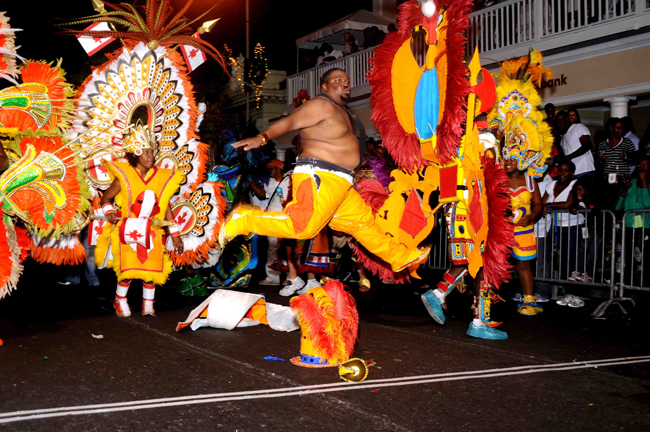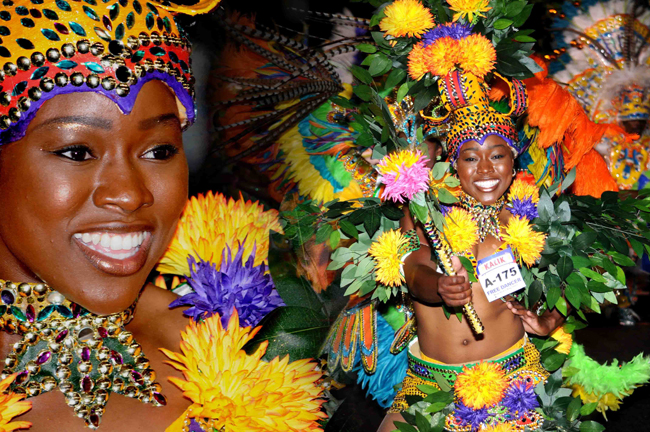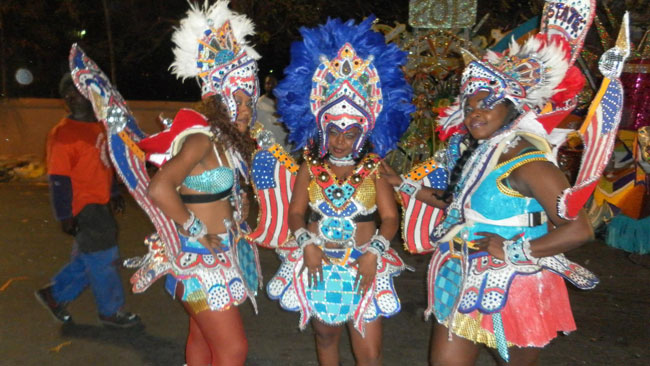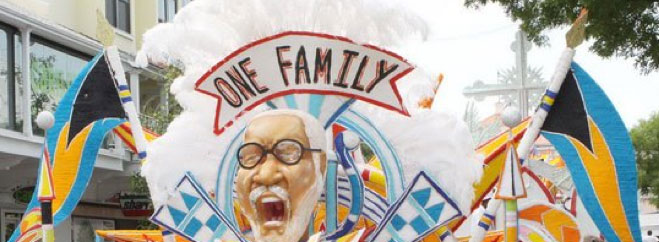From:TheBahamasWeekly.com
Junkanoo: Hidden Treasure of the Bahamas
By Katherine Beneby
Jun 13, 2014 - 2:17:59 PM

The Saxons (TM Photography)
|
As the cool breeze sweeps the crowd, friendly rivalry accelerates among supporters, and anticipation peaks at the sound of the drums. While the Junkanoo groups rush down Bay Street in downtown Nassau, they entice their supporters with a short call-and-response. Roots Junkanoo Group calls out, “Roots! There it is!” while the Valley Boys Junkanoo Group shouts, “Who are we? The Valley!”
Some see the fancy costumes, hear the melodious music and share in the hype of the crowds but do not grasp the true meaning of Junkanoo. “For me it goes beyond the parade and the competition; that is the gift wrapping,” said Arlene Ferguson, educator and head of EduCulture, an educational and cultural consultancy group. “The real gift is a tradition passed on by our ancestors which reflects the strength and spirit of the people of The Bahamas.”
Whether one is a participant or spectator, Junkanoo is not about age or social status; Junkanoo exemplifies what it means to be Bahamian and celebrates the culture of the Bahamas. This article paints a picture of the ultimate Junkanoo experience. The roots of this cultural festival stem from the continent of Africa. Junkanoo continuously evolves throughout the centuries. When the Bahamas represents at any major international event, Junkanoo often follows.
Most festivals around the world have elements of costuming and music. All of them, including Junkanoo, derive from unique backgrounds and have different reasons why parts of the Caribbean and the United States celebrate them.
During the late 15th century, the voyages of Christopher Columbus connected Europe to the Western Hemisphere. Europeans needed labor for their new colonies, which lead them to Africa. Throughout the early 16th century, “Africans were being ripped from their homeland and transported as slaves across the Atlantic in a triangular trading system that included Europe, Africa and the Americas,” Ferguson said. The Bahamas, a colony of Great Britain, became a part of the diaspora of Africans.
Africans toiling in the Bahamas came from the coastal areas of West Africa and the Congo. The birth of the Junkanoo festival came from rituals and ceremonies brought to the West in spirit and memories of the enslaved Africans. The most popular theory surrounding the name holds John Conny in high esteem. As an African tribal chief, he insisted on celebrating with his people even after being brought to the West Indies as a slave.
Under British law, slaves celebrated for three days off work during the Christmas holiday. “They came over here into a strange land, and they basically brought what they knew,” said Tony Hanna, Valley Boys Junkanoo Group member. They used this time to re-affirm who they were and to celebrate their heritage. In 1801, the first written documentation of Junkanoo in the Bahamas was recorded. Since then, the festival continues to grow through the centuries as a traditional Christmas celebration.
The early 20th century brought challenges to Junkanoo. Junkanoo groups represented different neighborhoods. The two main Junkanoo Groups, Valley Boys and Saxons Superstars, arose out of Centerville and Mason’s Addition, respectively. “Junkanoo came from a time where everyone rushed at the same time,” Hanna said. “One coming up the street, the next coming down the street, and they used to fight. When they passed through each other, they had rocks and bottles trying to burst your drums and hit you; it was violent.” In 1942, after the Burma Road Riots, a short-lived spontaneous outburst by a group of disgruntled laborers about socio-economic and political policies, the Bahamian government banned all street parades.

Valley Boys (TM Photography)
|
After a petition by the Citizens Masquerade Committee, Junkanno returned to Bay Street on New Year’s Day of 1948. The committee welcomed competition and formally introduced prizes in various categories. “In 1973 the management of the parades was turned over to the Bahamas Government, and the National Junkanoo Committee was formed as a statutory body with responsibility of overseeing the parades,” Ferguson said.
From finely-detailed costumes to sensational sounds, Junkanoo’s evolution continues to rapidly grow and develop. During slavery times, celebrants used leaves, paper and, basically, anything they found in their environment. Through the years, more resources became available like plants, straw, sponges, newspapers, tissue paper and the crepe paper often used today.
Costumes may be as tall as 15-feet. However, Hanna, a member of the brass section of the Valley Boys Junkanoo Group, must be uniformed. “Of course some of us take our own artistic abilities and swap some colors around just to be an individual in a group of many,” he said. “From far, all of us look the same, but when you come real close, you’ll see the difference.”
The amount of time it takes to construct a costume varies. “I could build a costume in a few days, but it depends on the intricacy of the costume itself, because the entire costume is fully cardboard,” Hanna said. “So it’s actually manipulating cardboard to bend in certain ways so you (the audience) might just see one curve, but to us we see about two or three sheets of cardboard.”
Slaves made their drums, namely the goatskin drum, a staple African instrument. They also substituted bells, rattles and shakers for cowbells, due to their availability on the plantations. The traditional horn of Junkanoo was a conch shell. Today, a variety of whistles and other horns, such as trumpets, sousaphones and trombones can be heard playing modern songs during parades. “When you have visitors around, you can tell from their reaction and their involvement that there is something very special about the sound of Junkanoo,” said Charity Armbrister, director of events at the Bahamas Ministry of Tourism.

Roots (Photo: Roots Junkanoo FB page)
|
Recently, the One Family Junkanoo Group introduced a new instrument, the “Konklu” which makes the sound “Kong ku lu.” It worked for them so other Junkanoo groups like the Valley Boys caught on and now use the instrument, too. “Saxons refuse to do it,” Hanna said. “They’re sticking to the old Junkanoo. But Junkanoo evolves because, at one point, there was no brass section.”
Tourists not only desire sun, sand and sea, but they want to participate in things Bahamian. “They are no longer satisfied in saying, ‘I’ve been to the Bahamas’; they want to say, ‘I experienced the Bahamas,’” said Anthony Stuart, general manager at the Bahamas Ministry of Tourism. “Junkanoo allows them to experience the Bahamas through music, art, heritage and community.”
Junkanoo has appeared at Miami’s Dolphins and Heat games; the Beverly Hills Pre-Oscar Party; and, most recently, the 50th anniversary celebration of Martin Luther King Jr.’s “I Have a Dream” speech in Washington, D.C., in 2013. “A few years ago, we had an opportunity to travel to Italy, and we spent two weeks down there at a major festival in Como called, ‘White Knights,’” said Christian Justilien, leader of the Colours Junkanoo group. “The people there really enjoyed Junkanoo. It was a wonderful experience to introduce the music to a different culture and to experience their culture as well.”
Growing opportunities to experience Junkanoo in the Bahamas creates optimism about the future of this festival. Several hotels host weekly Junkanoo events for guests; there are the Junkanoo Summer Festivals that are held in Nassau and the surrounding islands like Abaco, Andros and Eleuthera. Visitors to Nassau often attend the Sunday practice of Junkanoo sessions at Arawak Cay and Eastern Parade. Also, the Ministry of Tourism hosts Junkanoo rush-outs for groups or conferences, such as the recent Small Island Developing States Conference, Caribbean Hotel & Tourism Conference and international Miss Universe pageant.

One Family Photo
|
The Bahamas will host the “Bahamas Carnival 2015,” Armbrister said. “This will be a cultural explosion. It’s not only going to be Junkanoo, it’s going to be art, crafts, everything Bahamian.” The main Junkanoo parade still takes place during the Christmas holiday. Key attendees at the main Junkanoo parade are Bahamians. “It is estimated that there are about 5 percent spectator visitors,” Stuart said.
Junkanoo comes natural to Bahamians as a way of life. Some Bahamians dedicate most of their year to preparing for parades. “For me, Junkanoo is an outlet,” Hanna said. “Some people will spend however amount of money to go to a psychiatrist, just to tell somebody their problems. But, when I am out there, no matter what type of day I’m having, I have fun.”
Every year, Junkanoo with its fueling energy unites people from all walks of life to march to the beat of one sound: The Bahamas’ motto, “Forward, Upward, Onward Together” constantly revives the spirit and people of Junkanoo.
Katherine Beneby is a Bahamian media and communications specialist, currently working with the Red River Youth For Christ - North Dakota.
© Copyright 2014 by thebahamasweekly.com -